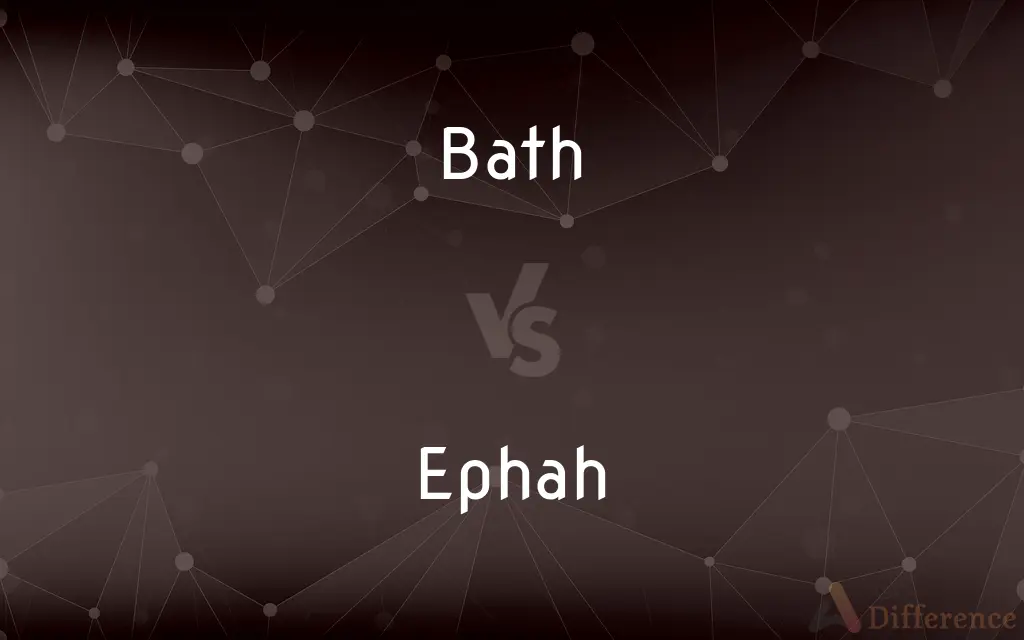Bath vs. Ephah — What's the Difference?
By Urooj Arif & Maham Liaqat — Updated on April 4, 2024
A bath is a unit of measurement for liquid volumes used in ancient times, particularly in the Hebrew Bible, while an ephah is a biblical unit of dry volume. Both are ancient measures but apply to different types of materials.

Difference Between Bath and Ephah
Table of Contents
ADVERTISEMENT
Key Differences
The bath is an ancient unit of measurement for liquids, referenced frequently in the Hebrew Bible, especially in contexts involving trade, offerings, and ceremonial practices. It was used to quantify volumes of liquid commodities like oil and wine. On the other hand, an ephah is mentioned as a unit of dry volume, primarily for grains and similar materials. This distinction between liquid and dry measurements underscores their respective roles in ancient economies and religious rituals.
Historically, the exact sizes of a bath and an ephah have been subject to scholarly debate, but they are often considered to be roughly equivalent, with the ephah being used for solids and the bath for liquids. For instance, one bath is generally thought to equal about 22 liters or 5.8 gallons, mirroring the ephah's volume, which suggests a close relationship in their capacities for the purpose of standardizing trade and commerce in ancient times.
In biblical context, the use of the bath and the ephah illustrates the meticulous nature of trade, offerings, and the maintenance of religious purity in ancient societies. While the bath would be used to measure out offerings of oil or wine to the temple, the ephah would serve a parallel purpose for offerings of grain or flour, demonstrating the comprehensive nature of ritual observance and the daily economy.
Culturally, these measurements reflect the sophistication of ancient civilizations in terms of their ability to regulate, standardize, and facilitate trade and religious practices. The precision in using different units for dry and liquid materials highlights an understanding of measurement that is nuanced and adapted to the specificities of the materials being traded or offered.
The ongoing scholarly interest in the bath and the ephah underscores their importance not just in historical measurement systems but also in understanding the economic and religious life of ancient communities. This interest points to a broader appreciation of how ancient peoples interacted with their environment and organized their societies, with specific measures playing a key role in these interactions.
ADVERTISEMENT
Comparison Chart
Type of Measure
Liquid volume
Dry volume
Biblical Context
Used for liquids like oil and wine
Used for dry goods like grain and flour
Estimated Volume
About 22 liters or 5.8 gallons
Roughly equivalent to a bath
Role in Society
Trade, offerings, ceremonial use
Trade, offerings, ceremonial use
Measurement Focus
Precision in liquid commodities
Precision in dry commodities
Compare with Definitions
Bath
An ancient unit of liquid volume.
The merchant traded three baths of olive oil.
Ephah
Roughly the same volume as a bath.
An ephah of grain equaled the volume of a bath of water.
Bath
Equivalent to approximately 22 liters.
A full bath could fill several jars.
Ephah
Integral to ancient trade and offerings.
Ephahs were standardized for fairness in trade.
Bath
Used in biblical times for religious offerings.
He offered a bath of wine at the temple.
Ephah
A biblical unit of dry volume.
She measured an ephah of barley for the market.
Bath
Indicates precision in trade of liquids.
The contract specified payment in baths of oil.
Ephah
Employed for grain and flour measurements.
The offering required half an ephah of flour.
Bath
Reflects economic and religious practices.
Baths were essential for temple ceremonies.
Ephah
Demonstrates measurement sophistication.
Using ephahs ensured accuracy in ancient commerce.
Bath
The act of soaking or cleansing the body, as in water or steam.
Ephah
Ephah (, Hebrew: עֵיפָה ‘Êp̄āh, Septuagint Γαιφα, Gaipha) was one of Midian's five sons as listed in the Hebrew Bible. Midian, a son of Abraham, was the father of Ephah, Epher, Enoch, Abida, and Eldaah by his wife Keturah (Genesis 25:4 ; 1 Chronicles 1:33).
Bath
The water used for cleansing the body
I'm going to run a bath.
Ephah
An ancient Hebrew unit of dry measure, equal to a tenth of a homer or about one bushel (35 liters).
Bath
A bathtub.
Ephah
A former Hebrew unit of dry volume (about 23{{nbsp}}L).
Bath
A bathroom.
Ephah
A Hebrew dry measure, supposed to be equal to two pecks and five quarts. Ten ephahs make one homer.
Bath
A building equipped for bathing.
Ephah
An ancient Hebrew unit of dry measure equal to about a bushel
Bath
Often baths A resort providing therapeutic baths; a spa.
Bath
A liquid in which something is dipped or soaked for processing
Immersed the metal in an acid bath.
Bath
A container holding such a liquid
Emptied the bath of dye.
Bath
A medium, such as oil or sand, that controls the temperature of objects placed in it.
Bath
A container holding such a medium.
Bath
An ancient Hebrew unit of liquid measure, equal to about 38 liters (10 US gallons).
Bath
A tub or pool which is used for bathing: bathtub.
Bath
A building or area where bathing occurs.
Bath
Clipping of bathroom
The master bath has two sinks.
Bath
The act of bathing.
Bath
The body of liquid one bathes in.
Bath
(by extension) A substance or preparation in which something is immersed.
A bath of heated sand, ashes, steam, or hot air
Bath
A former Hebrew unit of liquid volume (about 23{{nbsp}}L or 6 gallons).
Bath
To wash a person or animal in a bath.
Bath
To bathe oneself; to have a bath.
Bath
The act of exposing the body, or part of the body, for purposes of cleanliness, comfort, health, etc., to water, vapor, hot air, or the like; as, a cold or a hot bath; a medicated bath; a steam bath; a hip bath.
Bath
Water or other liquid for bathing.
Bath
A receptacle or place where persons may immerse or wash their bodies in water.
Bath
A building containing an apartment or a series of apartments arranged for bathing.
Among the ancients, the public baths were of amazing extent and magnificence.
Bath
A medium, as heated sand, ashes, steam, hot air, through which heat is applied to a body.
Bath
A solution in which plates or prints are immersed; also, the receptacle holding the solution.
Bath
A Hebrew measure containing the tenth of a homer, or five gallons and three pints, as a measure for liquids; and two pecks and five quarts, as a dry measure.
Bath
A city in the west of England, resorted to for its hot springs, which has given its name to various objects.
Bath
A vessel containing liquid in which something is immersed (as to process it or to maintain it at a constant temperature or to lubricate it);
She soaked the etching in an acid bath
Bath
You soak your body in a bathtub;
He has a good bath every morning
Bath
A relatively large open container that you fill with water and use to wash the body
Bath
An ancient Hebrew liquid measure equal to about 10 gallons
Bath
A town in southwestern England on the River Avon; famous for its hot springs and Roman remains
Bath
A room (as in a residence) containing a bath or shower and usually a washbasin and toilet
Bath
Clean one's body by immersion into water;
The child should bathe every day
Common Curiosities
Can the exact sizes of a bath and an ephah be determined today?
While the exact sizes are subject to scholarly debate, they are generally estimated to be about 22 liters, indicating efforts to standardize measurements in ancient times.
Are the bath and ephah equivalent?
Yes, they are often considered roughly equivalent in volume, with one major difference being that the bath measures liquid and the ephah measures dry goods.
Are there modern equivalents to the bath and ephah?
Modern measurement systems have equivalents, but the exact historical volumes of the bath and ephah are specific to their ancient contexts.
Did the use of the bath and ephah vary across different ancient cultures?
While specific to the biblical context, variations and equivalents of these measures were likely adapted across different ancient cultures for similar purposes.
How was the ephah used in ancient societies?
The ephah was used as a unit of dry volume, particularly for measuring grains and flour in trade and religious offerings.
What does the use of these measurements tell us about ancient civilizations?
The use of the bath and ephah reflects a sophisticated understanding of measurement, trade, and religious practices, highlighting the complexity of ancient societies.
What is a bath in biblical terms?
In biblical terms, a bath is a unit of measurement for liquids, used for things like oil and wine in ancient times.
Why were different units used for dry and liquid materials?
Different units allowed for more accurate and appropriate measurements for the physical properties of dry and liquid materials, facilitating trade and religious ceremonies.
How do scholars determine the volumes of ancient measurements like the bath and ephah?
Scholars use historical texts, archaeological findings, and cross-cultural comparisons to estimate the volumes of these ancient measurements.
What significance did these measures have in religious contexts?
In religious contexts, they were used for precise offerings of goods to temples, reflecting their importance in ceremonial practices.
How did the bath and ephah contribute to the economy?
They played crucial roles in standardizing measurements for trade, ensuring fairness and precision in the exchange of goods.
How accurate were measurements like the bath and ephah in ancient times?
These measurements were likely as accurate as possible within the technological and scientific understanding of the time, crucial for trade and religious practices.
Can learning about ancient measures like the bath and ephah help in understanding the Bible?
Yes, understanding these measures can provide insight into the economic, social, and religious life depicted in the Bible.
What role did standardization of measures like the bath and ephah play?
Standardization facilitated fair trade, economic stability, and the orderly conduct of religious rituals in ancient societies.
What challenges do historians face in studying ancient units of measurement?
Challenges include the lack of standardized units across cultures, variations in interpretations of ancient texts, and estimating volumes based on archaeological evidence.
Share Your Discovery

Previous Comparison
Clink vs. Chink
Next Comparison
Inventory vs. SurveyAuthor Spotlight
Written by
Urooj ArifUrooj is a skilled content writer at Ask Difference, known for her exceptional ability to simplify complex topics into engaging and informative content. With a passion for research and a flair for clear, concise writing, she consistently delivers articles that resonate with our diverse audience.
Co-written by
Maham Liaqat













































